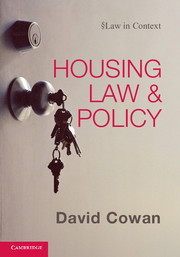Book contents
- Frontmatter
- Contents
- Preface
- List of abbreviations
- Table of legislation
- Table of international instruments
- Table of cases
- 1 Locating housing law and policy
- Part I Regulation of housing tenure
- 2 Regulating ownership
- 3 Regulating private renting
- 4 Regulating local authority housing
- 5 Regulating private registered providers
- Part II Access to housing
- Part III Rights and responsibilities
- Postscript
- Bibliography
- Index
4 - Regulating local authority housing
from Part I - Regulation of housing tenure
Published online by Cambridge University Press: 05 June 2012
- Frontmatter
- Contents
- Preface
- List of abbreviations
- Table of legislation
- Table of international instruments
- Table of cases
- 1 Locating housing law and policy
- Part I Regulation of housing tenure
- 2 Regulating ownership
- 3 Regulating private renting
- 4 Regulating local authority housing
- 5 Regulating private registered providers
- Part II Access to housing
- Part III Rights and responsibilities
- Postscript
- Bibliography
- Index
Summary
In the previous two chapters, we looked at the regulation of private sector housing – owner-occupation and private renting. In this chapter and the next (concerning PRPs), our focus shifts to what has become known as the ‘social sector’ or, more simply, ‘social housing’. This phrase is controversial, but broadly is taken to mean the provision of low-cost housing by non-profit-making providers to households in need (see Cowan and McDermont 2006; 2009). Just under 17.5% of properties in England are rented from social housing providers; and just under 9% are rented from local authorities. At its peak, though, around 30% of properties were rented from local authorities. The decline in local authority housing stock has taken place largely in the last thirty years. Nevertheless, council housing remains responsible, in numerical terms, for 1.8 million properties – a decline from the 3 million for which it was responsible in 2000 (CLG 2010d).
In years to come, it may well be that both the social housing chapters will be able to be combined because the regulatory structures and strategies will be the same. It may also be that direct provision of housing by local authorities will have been phased out. However, we have not reached that point yet. Housing law and policy currently remains stubbornly different in relation to each of the social housing tenures. While PRPs are given more freedom, local authorities are relatively constrained in what they are able to do.
- Type
- Chapter
- Information
- Housing Law and Policy , pp. 76 - 101Publisher: Cambridge University PressPrint publication year: 2011



